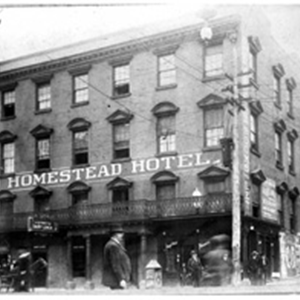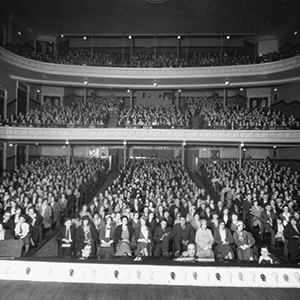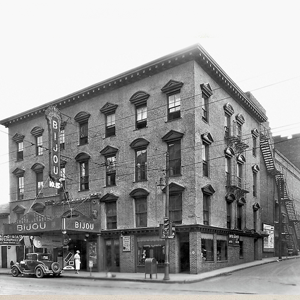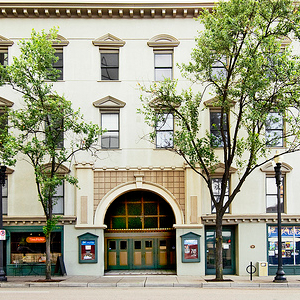
1801-1856
The Premiere Hotel in Knoxville
The Bijou Theatre, a pillar in Knoxville’s rich history, began as The Lamar House more than two centuries ago. Sitting on a parcel once granted to Revolutionary War general James White, it is believed to be the oldest commercially active property in Knoxville ─ possibly in Tennessee.
Read More
The story of the building begins in 1801 when Thomas Humes purchased “Lot 38” on the corner of Gay Street and Cumberland Avenue. In 1815 Humes began work on the property intending it to be a hotel, tavern and three separate storefronts. Humes died, however, in 1816 before the construction was completed in 1817 ─ foreshadowing years of tumultuous ownership and management of the building.
The entrance of what would become known as The Knoxville Hotel was located in the building’s grand center archway and, with three stories, 13 guest rooms, a bar, ballroom (on the 3rd floor in the NW Corner) and dining room, the luxurious hotel soon became the place for elite social gatherings. One of the first high-profile events hosted in the ballroom was attended by President Andrew Jackson in the March of 1819.
From 1820 through 1850s the property changed hands from members of the Humes family to several enterprising businessmen. During this early period it was known variously as the “Jackson Hotel,” “City Hotel,” and “Coleman House,” but in 1856 it returned to the name “Lamar House.”
In 1852 W. M. Churchwell purchased the hotel and took on ambitious renovations, doubling its previous size and adding new features including an elevator, a new kitchen, parlors, dining room, a special “ladies' entrance,” courtyard and stables. During this time the regrading and cobbling of Gay Street removed so much earth that it added an extra story to the front of the building.

1857-1908
Lamar House in the Civil War
In 1857 ownership of the building again changed hands, this time to a Colonel William H. Sneed, the owner of an adjacent property. Sneed leased the building for profit and the hotel passed through a succession of tenants. Still, The Lamar House continued to serve as a center of the Knoxville social scene and underwent still more opulent remodeling.
Read More
During the American Civil War the Union Army, under General Ambrose Burnside, eventually occupied the town of Knoxville. The Lamar House, initially occupied by Confederate officers, was taken over by the Union Army and served for a time as a hospital ─ “The Lamar Hospital.” During the Union occupation, Generals William Sherman and Phil Sheridan made Lamar Hospital their headquarters and laid out their plans for battle on the dining room table. General William P. Sanders died in the hotel’s Bridal Suite on November 19, 1863.
In 1869, in unclear circumstances, William Sneed died, and over the next few years the property passed from one member of the Sneed family to another. By 1881 it had been owned by seven people. The name again changed repeatedly ─ first to “The White House”, then “New Lamar House” and finally in 1904 to the “Old Homestead.”
In September of 1877 President Rutherford B. Hayes paid a visit to Knoxville and made a speech from the building’s balcony. In subsequent years, however, the migration of industry and the construction of larger hotels caught up with Lamar House, and the hotel underwent financial hardship and struggled through several changes in management.

1908-1935
Vaudeville Comes to Knoxville!
In 1908 the Auditorium Company purchased the property and began renovations to remodel and transform the ballroom into a theater ─ named Jake Well's Bijou Theatre. The original Lamar House building would continue to operate as hotel, store and restaurant. The venture was financed by three of Knoxville's prominent citizens: C.B. Atkin, Mrs. Jeanette Cowan, and W.G. Brownlow. Managing partners were Jake Wells and Fitz Staub.
Read More
The theater opened March 8, 1909 to a sellout crowd, hosting a production of "Little Johnny Jones" starring George M. Cohan. The Knoxville Sentinel proclaimed the Bijou Theatre to be "one of the best constructed and most conveniently arranged houses in the entire south". Vaudeville was the mainstay of the theatre from 1913 to 1926, with the occasional motion picture being shown as well.
From its beginning, the Bijou Theatre had a policy of admitting Black patrons, though they were restricted to the second balcony. A separate entrance for African Americans was located on Cumberland Avenue. Notably, it was one of the few theaters in Knoxville that admitted both Black and white patrons during the early to mid-20th century, prior to desegregation in the 1960s.
In 1926 construction began on the Tennessee Theatre, also located on Gay Street. The owners of The Tennessee Theater purchased the Bijou but later sold to a local businessman with the stipulation that for the next five years the theater could not be used for theatrical productions of any kind.
In 1928 The Bijou Theatre suffered the indignity of becoming essentially a used car lot for the Mahan Motor Company. The theater entrance became The Bijou Fruit Stand and, according to local lore, the first bananas ever sold in the Knoxville were sold there. In 1932 the storefront on the south end opened up one of the first Chinese-American restaurants in the South ─ the beloved Pagoda.

1935-1969
Our Theater Gets Adult....
In 1935 a Paramount Pictures distribution subsidiary took a 30-year lease on the Bijou and operated it as a movie house to show second-runs and holdovers of films that had already been shown at the Tennessee Theatre. The cinema did, on occasion, turn its stage over to touring performers and orchestras and the Bijou saw many notable performers. In 1965 Paramount chose not to renew, and the theater became an “adult” movie house. The name was changed to the “Bijou Art Theatre.”
Read More
By this time Downtown Knoxville was slowly deteriorating. By 1957 the Lamar Hotel had been reduced to a home for transients and prostitutes. Consequently, when rumors of the hotel’s dealings arose there came a public outcry to put the hotel out of business. In 1969 ─ after 152 years in operation ─ it was declared a public health hazard and closed. The theater, however, continued to operate.

1971-2004
Save the Bijou!
In 1971 the Lamar House was bequeathed to Church Street United Methodist Church. The church, unhappy about owning the once ill-reputed house, quickly sold it to a Knoxville businessman. In 1975, the Bijou Theatre was finally closed due to unpaid rent and amusement taxes. As a result Knoxville's grand theater was scheduled for demolition.
Read More
But that same year The Bijou Theatre was added to the list of historical places in the National Historic Record and the Knoxville Heritage Group launched a campaign to halt the destruction of this grand building. When the deadline came, the group was short by $50,000. For two weeks the fate of the Bijou was unsure, until John S. Goodstein, acting trustee for the Bijou, donated the remaining $50,000.
The theater, still in dire need of a full-scale restoration, but with little money or direction, reopened in 1977. In 1982 the Bistro at the Bijou opened, continuing the long tradition of beloved restaurants occupying the south end of the Lamar House. In 1984 the board of directors decided that the theater was in need of more extensive repairs, and appointed an Executive Fundraising Director experienced in theater restoration. More than one million dollars was subsequently raised and, by end of 1985, The Bijou was in the best physical condition it had been in for decades. Throughout the 1980s and early 90s The Bijou continued to enjoy success in the areas of the dramatic and performing arts. In January 1995, another fundraising drive began to restore the Bijou further, but when completed in 1999 the final cost was more than the amount pledged. The theater had to be mortgaged and, by May 2004, was forced to shut down and discontinue all programming.
2005-Present
We're Back & Better Than Ever!
On March 30, 2005, Mayor Bill Haslam announced a strategy to ensure that the historic Bijou Theatre remained a Knoxville treasure for future generations and helped bring in federal support for the restoration and preservation of the theater. In 2006, the doors were opened again and have remained so with a healthy board, management company and stable operations. In 2009 the Bijou celebrated it's 100th birthday ─ a celebration that has since evolved into an annual event called the Bijou Jubilee.
Read More
Today, the Bijou continues to serve the city of Knoxville as one of the most outstanding entertainment centers in the world with some of the most perfect natural acoustics in the nation. In its era it has made its mark in the entertainment industry by presenting operas, musicals, orchestral concerts and comedy shows. It has hosted many well-known artists such as The Marx Brothers, Anna Pavlova, Lunt & Fontaine, Dizzy Gillespie, Dolly Parton, The Ramones, Dave Matthews Band and so many more. The Bijou has withstood wars and fires, and throughout its many name changes and structure changes, it has remained Knoxville's Gem of the South.